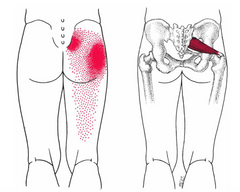Piriformis is a deep glute muscle that can cause a ton of pain in the tailbone and outer glute area [1]. This post covers what Piriformis muscle tension feels like, how to determine if it is causing the pain, and most importantly how to release it for relief.
We use our QL Claw for Piriformis release - learn more about our tool here.
Piriformis Release with QL Claw
Piriformis Release Placement:


Piriformis Release Written Tutorial:


Placement: Sit with the tailbone directly on the ramp (the big end) of the Claw, and let the leg fall to the side - the trigger should dig right into Piriformis. Piriformis can be described as in the outer lower pocket of the glutes - see anatomy image below for reference. You will know you are on it when you feel a very tight, tender spot in the outer buttock area.
Motion: Light, gentle motion is best for Piriformis release. Move the leg on the massage-side up and down to hook into the muscle and break up any tight spots.
Additional Pressure 1: Cross the massage-side leg over the opposite knee in a figure-four position. Tilt the body into and away from the trigger (in a back-and-forth rocking motion) for deep, active Piriformis release.

Additional Pressure 2: From Additional Pressure 1, elevate the upper body onto the elbows. This will shift the weight that is currently on your upper back directly into the Piriformis muscle for release.
How to know you've released a trigger point: When you release a knot/trigger point, you will feel the muscle give and will simultaneously feel the device sink into your body. A massage generally feels less painful under higher pressure once a trigger point is released.
Piriformis Release FAQ:
Piriformis And SI Joint Release Techniques
Massage and stretching are your best bets for Piriformis-related SI joint pain. Massage is great for releasing the rigid, constant strain of the Piriformis muscle, and stretching is great for further lengthening the muscle for additional function and pain relief (seated Piriformis stretch).
How Do I Get My Piriformis Muscle To Release?
Deep tissue massage is often the only way to release a tight Piriformis muscle. If you have tried stretching or strengthening movements unsuccessfully, try Piriformis muscle release with massage to break through.
How To Release Sciatic Nerve From Piriformis
The sciatic nerve can be compressed by the Piriformis muscle - also known as Piriformis syndrome (more below). Massage and stretch the Piriformis daily to release its pressure off of the sciatic nerve.
Piriformis Release - Pain Symptoms
Piriformis Anatomy & Function:
Piriformis is a deep glute muscle that connects from the sacrum (tailbone) to the top of the femur. It lies underneath the large Gluteus Maximus muscle and causes a ton of complications when tight. The main function of the Piriformis is to rotate the leg outward as an external hip rotator [1]. Piriformis works hard during activities with lateral movements like tennis and basketball. It is during these activities that Piriformis pain can originate due to overworking the Piriformis muscle.

Piriformis Muscle
Piriformis Symptoms & Pain Patterns:
Piriformis pain will typically occur at the tailbone and outer buttock regions. See the bright red region in the image below for reference.
Piriformis injuries typically originate during a high-impact activity, but become aggravated from sitting. Sitting may feel very uncomfortable, and you may not be able to sit still for consecutive minutes without pain [1].

Piriformis Pain Pattern (left) and Piriformis Muscle (right) [1]
Piriformis Syndrome:
Piriformis Syndrome occurs when the Piriformis muscle is so tight that it compresses the sciatic nerve. This can cause pain, numbness, or tingling running down the leg all the way to the foot. See a Piriformis Syndrome Test here.

Piriformis Syndrome Nerve Compression [2]
Signs You Need Piriformis Release
Symptom 1: Duck Feet
Duck feet (toes pointed outward) are a great sign you may have Piriformis tension that would benefit from myofascial release. The reason behind this is a tight Piriformis muscle will externally rotate the leg and point the toes outward. If you have duck feet, try Piriformis release via massage and see if your feet naturally point more straight forward.
Symptom 2: Glute & Tailbone Pain
The following pain pattern, as illustrated by Travell and Simons, displays the areas in the body where Piriformis trigger points and tightness can refer pain [1]. The bright red areas are most prominent at the tailbone and outer glute, so if you feel a nagging pain in those areas Piriformis release may be for you.

Piriformis Trigger Point Referred Pain Pattern [1]
Symptom 3: Buttock Pain from Sitting
Piriformis muscle pain is typically triggered by a single high-impact event (like playing basketball for the first time in years, breaking into a sprint without warming up, etc.), but can be made chronically worse by sitting [1]. This is due to the shortening of the Piriformis muscle that can happen when sitting in chairs, which aggravates an already tight muscle. If you sense the pain pattern above when sitting for long periods, Piriformis massage is something worth looking into.
Symptom 4: Piriformis Syndrome
Piriformis Syndrome is a gnarly phenomenon where the Piriformis muscle gets so tight that it compresses the sciatic nerve and shoots pain, numbness, and/or tingling down the leg. The links below have much more detail about Piriformis Syndrome so I will not go into too much detail here, but Piriformis release massage could be the ticket to relieving this debilitating problem.
How To Sit With Piriformis Syndrome
Piriformis Release:
Scroll up to see how effective QL Claw is as a Piriformis release tool!
Check out our other tutorials for releasing other low back pain-inducing muscles below!
Sources/Influences:
[1] Donnelly, Joseph M. Travell, Simons & Simons Myofascial Pain and Dysfunction: the Trigger Point Manual. 3rd ed., Wolters Kluwer Health, 2019.
[2] Davies, Clair, and Amber Davies. The Trigger Point Therapy Workbook: Your Self-Treatment Guide for Pain Relief. 3rd ed., New Harbinger Publications, Inc., 2013.


